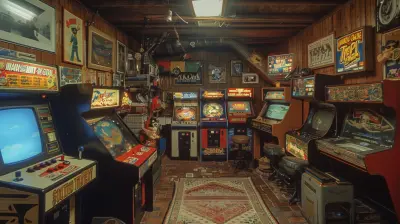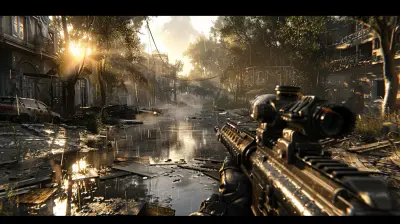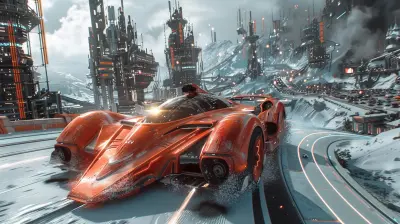How to Use Feedback Loops in Game Design for Better Player Experience
16 October 2025
Imagine you're playing an intense boss fight. You strike, dodge, block, and just barely survive with a sliver of health. Your heart races. You triumph. Victory never felt sweeter. Why is that?
That, my friend, is the magic of a well-crafted feedback loop.
Game design isn't just about shiny graphics or epic soundtracks—it's about emotion, rhythm, and flow. And feedback loops? They're the unsung heroes turning games from "meh" to "masterpiece." Let’s crack open this concept and see how feedback loops can fine-tune your player's journey into something unforgettable.
🎮 What Are Feedback Loops in Game Design?
First things first—what even is a feedback loop?In plain English, a feedback loop is a system within a game that reacts to a player's actions and influences what happens next. Think of it as a cycle. You act, the game responds, you adjust, and boom—you’re in a loop.
There are two main types:
- Positive Feedback Loops: These amplify actions. Win a round? Get stronger. Got stronger? Win more. It's a snowball rolling downhill, gaining speed and size.
- Negative Feedback Loops: These balance the system. Fall behind? Here’s a boost. Get too far ahead? Here's a challenge. It’s like the rubber band mechanic in racing games—keeps things tight, thrilling, and fair.
🧠 Why Feedback Loops Matter More Than You Think
Think of feedback loops as a conversation between the player and the game. If the game's too quiet, players feel lost. If it screams, they tune out. But balance that feedback just right? Now you're groovin’.Here’s why they’re vital:
- 🎯 They guide player behavior
Without nudges in the right direction, players might flail or exploit the system.
- 🎢 They control difficulty curves
Too easy? Players yawn. Too hard? They rage-quit. Feedback loops smooth that ride.
- 💬 They create emotional payoffs
That dopamine hit from leveling up or unlocking a new power? All feedback, baby.
⚙️ Positive Feedback Loops: The Power Rush
Let’s sink our teeth into positive feedback loops.You earn gold. You buy better gear. Now you slay enemies faster. That earns more gold. You see where this is going?
This loop is all about momentum. It escalates tension, drama, and consequence. It’s thrilling—but if it goes unchecked, it breaks the game.
💡 Where Positive Feedback Shines
- Power fantasy games (like Diablo or God of War): Let players become unstoppable forces.- Competitive strategy games: Reward smart tactics with exponential gains.
- Progression-heavy mobile games: Skinner box? Maybe. Addictive? Definitely.
⚠️ Beware the Doom Spiral
Ever played a game where falling behind means you’re effectively toast? That’s a badly tuned positive loop. It's great when you're winning, but punishing when you're not.That’s why designers often combine positive loops with negative ones—to keep things spicy but not savage.
🔄 Negative Feedback Loops: The Great Equalizer
If positive loops are the gas pedal, negative loops are the brakes.These loops stabilize gameplay. They keep you from crashing and burning after one bad move. They also make games more accessible, fair, and long-lasting.
🌊 Where Negative Feedback Shines
- Multiplayer games (Mario Kart, anyone?): Rubber banding helps the underdog catch up.- Roguelikes: Random buffs after death keep you hopeful.
- Narrative games: Story moments that scale with performance to deliver emotional consistency.
Negative loops are what make you say, “I lost, but I could’ve won.” That’s the juice. That’s replayability screaming your name.
🧬 Combining Feedback Loops for Dynamic Design
The real magic happens when you blend feedback loops like a master chef.Imagine this:
- Early game = forgiving negative loops to keep newbies hooked.
- Mid game = empowering positive loops that reward learned skills.
- Late game = a mix, customizing difficulty based on performance.
It’s not about picking one loop over the other—it’s about weaving them into a living, breathing ecosystem that adapts to your player.
🛠️ Real Game Examples
- The Legend of Zelda: Breath of the Wild: Explore at your pace. Fight with what you find. The world adjusts subtly.- Civilization VI: Snowball with smart tactics (positive), but AI adapts and challenges (negative).
- Dark Souls: Brutal positive loops when you master mechanics. Negative loops kick in if you lag, like giving you more practice time with safe zones.
🧪 How to Craft Effective Feedback Loops
Alright, so you’re sold on the idea. But how do you actually design these loops without turning your game into a confusing mess?Glad you asked.
1. Observe Player Behavior Early
Watch how players mess with your mechanics. If everyone’s picking the same weapon or avoiding the same path, something’s off. Your loop could unintentionally be too rewarding or too punishing.2. Use Visual and Audio Feedback
Players need to "feel" the loop, not just see it. That satisfying "ding!" when you level up? That's part of the loop. That red screen flash when you take damage? Yup, feedback.Never underestimate the power of feedback you can hear, see, and even feel through haptics.
3. Create Short and Long-Term Loops
Short-term loops keep the player moment-to-moment engaged:- Hits that stagger enemies.
- Sound effects after a perfect dodge.
- Combo counters.
Long-term loops give broader goals:
- Unlocking a new area.
- Upgrading to a legendary weapon.
- Reputation changes with in-game factions.
Balance both. It’s like giving players both popcorn and a three-course meal.
4. Let the Loops Adapt Over Time
A smart game grows with its player. Early on, you might need training wheels. Later, you want full throttle.Design your systems so that feedback loops evolve—either automatically or based on player actions. That way, returning players feel respected, not babied.
💬 Player Psychology and Feedback Loops
We’re diving deep now. Let’s talk player brains.At the heart of it all, feedback loops mess with our dopamine systems. Little rewards? They light us up like a pinball machine.
But if loops are too generous, we get numb. If they’re too stingy, we quit. The sweet spot comes when players feel like they’re earning their progress.
It’s all about agency.
When a player feels like, “I did this, and the game noticed,” that’s where magic lives. Feedback loops aren’t just about balance—they’re about recognition.
🌱 Evolution of Feedback Loops in Modern Games
Back in the day, loops were simple.- Jump on a Goomba—get points.
- Collect enough rings—gain a life.
Today? Loops are layered.
- Hidden mechanics.
- AI-driven difficulty adjustments.
- Social systems that react to community input.
Games like Hades and Returnal use procedural generation and performance-tracking to adjust feedback in real-time. It’s like the game’s alive—watching, reacting, whispering, “I see you.”
📝 Final Thoughts: Design Loops with Heart
At the end of the day, feedback loops aren’t just systems or code. They’re stories told through mechanics. They’re the invisible hands guiding your player’s journey—uplifting them, challenging them, and keeping them dancing to the rhythm of your game world.Design with empathy. Test with intention. Tune with obsession.
Because when you get feedback loops right? You don’t just build a game. You build an experience players carry with them long after the credits roll.
Now go. Close that loop.
🔁 Quick Recap: Feedback Loop Checklist
Before we wrap up, here’s a speedy recap you can bookmark:☑️ Positive loops = amplify success
☑️ Negative loops = balance struggle
☑️ Use both to build dynamic pacing
☑️ Tune with player behavior in mind
☑️ Mix short and long-term loops
☑️ Always prioritize feedback clarity (visual, auditory, tactile)
☑️ Give players meaningful agency
Like any great game, loops are about the journey—so make yours unforgettable.
all images in this post were generated using AI tools
Category:
Game DesignAuthor:

Aurora Sharpe
Discussion
rate this article
1 comments
Olympia Allen
Great insights! Embracing feedback loops can truly elevate player experiences. It's like giving your game a magic potion—turning challenges into triumphs! Keep those creative ideas flowing! 🎮✨
October 24, 2025 at 3:50 PM

Aurora Sharpe
Thank you! I’m glad you found the insights valuable. Embracing feedback is indeed a powerful way to enhance player experiences! 🎮✨


